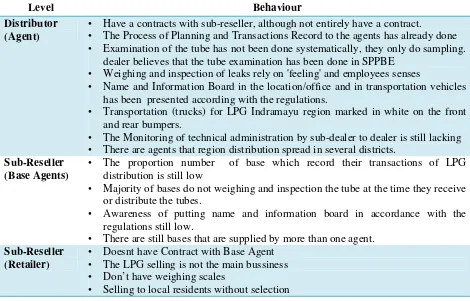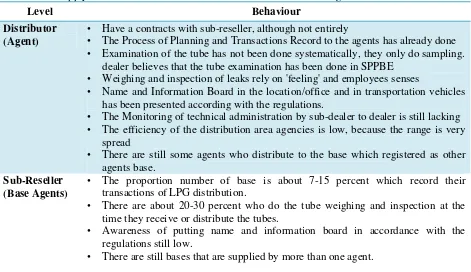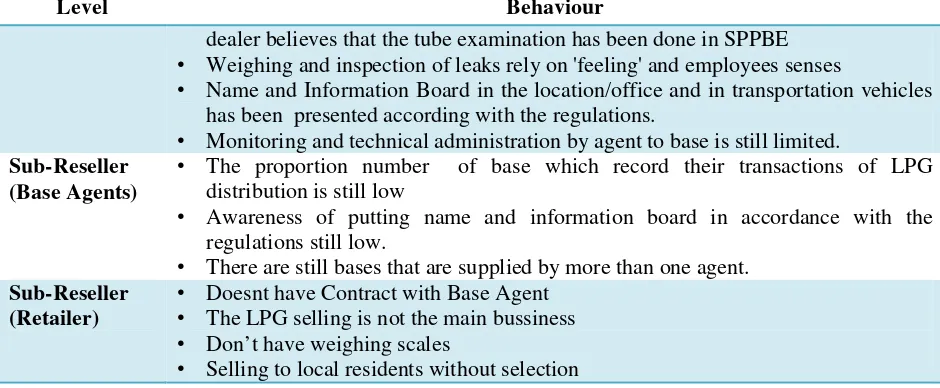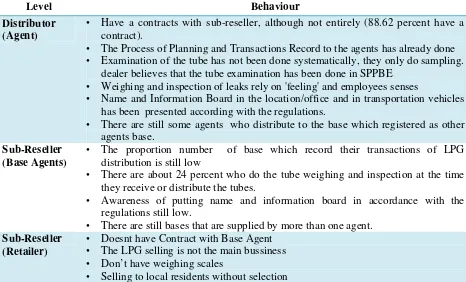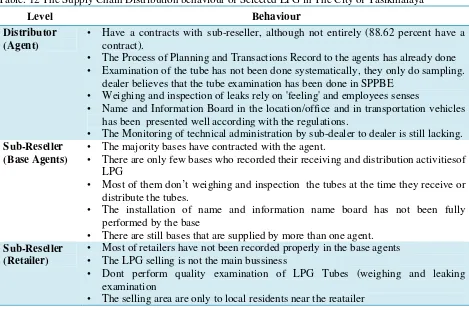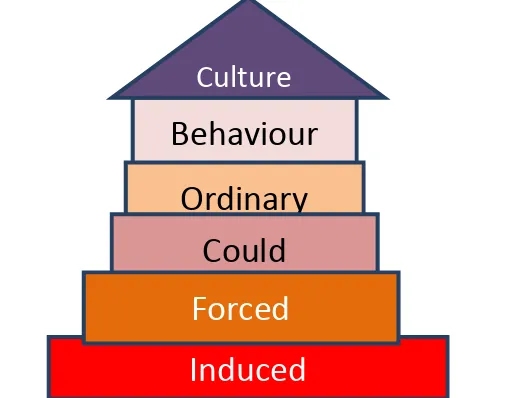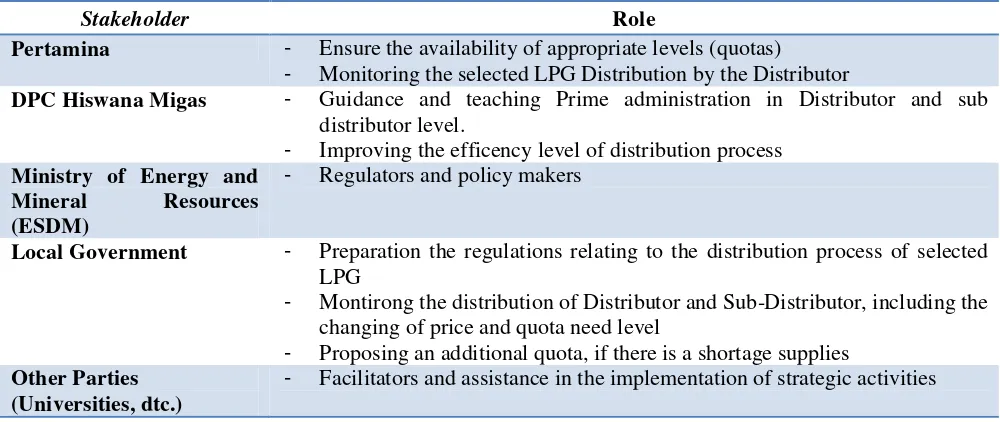1 The Design and Implementation of 3 Kg Liquified Petroleum Gas (LPG) Closed-Loop Supply Chain
System by the Role of Stakeholders
Case Study at Indramayu, Subang, Purwakarta, Kuningan and Tasikmalaya, West Java
Lindawati Kartika1 *), Andita Sayekti1 Departement of Management FEM-IPB
Abstract
The existence of competition among the 3 Kg LPG distributors makes fluctuation at downstream demand, so the amount of tube safety stock owned by distributor becomes very high. Currently scenario, scenario which retailers cat get supplies from a number of different agents and move to another agency, cause demand instability at SPBE and agents. Government makes policy for kerosene conversion to gas according with Republic of Indonesia Presidential Regulation No. 104 in 2007 concerning supply, distribution determination of 3 Kg LPG for households and micro-enterprises to solve that problem. This policy was followed up by Minister of Energy and Mineral Resources (ESDM) Regulation, which is Regulation No. 26 in 2009 concerning LPG supply and distribution, No. 17 and 5 in 2011, and No. 1714 in 2012 on the 3 Kg LPG benchmark prices establish enclosed scenario to assist in monitoring of LPG distribution, either quantity, quality or distributor.
The objective of this study is the arrangement by enclosed system of specified LPG distribution by optimizing the role of stakeholders, so only groups of people with certain criteria are entitled to get distribution with guaranteed quality. The results of this study, alternative strategy, are policy recommendation that can assist in the monitoring and distribution of LPG by the role of stakeholders.
Keywords: closed-loop supply chain, LPG, SPBE, stakeholders
1. Introduction
1.1. Background
Convertion policy of kerosene to gas in accordance with Presidential Regulation No. 104 in 2007 concerning supply, distribution and establishment of 3 Kg LPG directed to households and micro-enterprises. This was followed up by Minister of Energy and Mineral Resources (ESDM) Regulation, among others ESDM No. 26 Year 2009 concerning the supplying and distribution of LPG, along Minister of Internal Affairs Regulation and Minister of Energy and Mineral Resources No. 17 and 5 in 2011 and the Minister of Energy and Mineral Resources No. 1714 in 2012 on the benchmark prices of 3 Kg LPG. The mission of closed-loop supply chain arrangement especially refers to Minister of ESDM Regulation No. 26 in 2009.
Some highlights of the Minister of ESDM Regulation No. 26 in 2009 is the definition of the user, and the implementation and the selling price and sanctions for violators [4]. Users of LPG consist of Commercial LPG and Certain LPG. Users of Commercial packaging are LPG by 12 Kg, 50 Kg, and other packaging in the form or in bulk form (LPG) and LPG consumers’ as a coolant. Users of Spesific LPG are consumers of LPG households and micro-enterprises that use LPG in tubes 3 Kg with the price regulated and determined by the Minister (Article 20).
Implementation of closed-loop supply chain for 3 Kg LPG users done gradually by considering: (1) the purchasing power of 3 Kg LPG users, (2) security and continuity of supply and distribution of 3 Kg LPG; and (3) the availability of LPG distribution facilities. Implementation of the monitoring carried out in collaboration with the Directorate General of related agencies, especially the Local Government, Police and implementing Enterprise assignment supply and distribution of 3 Kg LPG. This implementation also used the control card (Articles 21 and 22).
Selling price of 3 Kg LPG consists of the reference price and the retail price. Reference price set by the Minister of Trade and the retail price is coordinated by the Minister of Economy. While the ceiling price (HET) set by the local government for the user at the point of transfer in certain sub-distributors LPG adjusted to local conditions, purchasing power, a reasonable margin and LPG supply and distribution facilities (Article 24).
2 The mission of this arrangement in order to be effective must consider the distribution, the target (user) and other aspects including socio-cultural and economic conditions of the region.
Closed-loop supply chain according to the Guide and Van Wassenhove (2000) is a flow velocity ranging from consumer products, back to the factory for reprocessing and then returned to consumers as goods to be consumed back [2]. Meanwhile, according to Dyckhoff (2004) explained that a closed-loop supply chain is a cycle-oriented strategy with management chain / supply network, recycling and environmentally friendly disposal. [3]
1.2.Purpose
The purpose of this study is the arrangement to ensure closed-loop supply chain on LPG so that only certain groups of people with certain criteria are entitled to a distribution with guaranteed quality. From macro aspect, the goal is to increase efficiency closed-loop supply chain and effectiveness of subsidies for 3 Kg LPG of a state-subsidized goods. Another aim is to stabilize prices and guarantee the availability of LPG. Price stabilization is basically expected at the user level through the establishment of ceiling price (HET). Benefits of closed-loop supply chain are helping process control / monitoring of the distribution of LPG, include of the quantity, quality and distribution actors.
According to the Minister of Natural Resources Regulation and Energy No. 26 in 2009, Closed-lopp supply chain is a particular system distribution of selected LPG for household or micro-enterprises that use certain LPG registered using a control card. This control card is the official identification given to households and micro-enterprises that use selected LPG as a surveillance tool in particular LPG distribution.
2. Research Methods
This research was conducted with a qualitative descriptive approach. According Bondan and Taylon in Moleong (2001) explains that qualitative methods as a research procedure that produces descriptive data in the form of words written or spoken of the people and observed behaviour, directed as a whole (holistic) [1].
How to obtain the data and information needed in this study are:
a. Review of the number of references, books, reports, regulations and documents that are relevant to this study, ranging from defining the concept, implementation, writing, analysis, conclusions and suggestions.
b. Field observations on the process of 3 Kg LPG supply that can support and complement the information on research interests.
3 Figure.1 Flow of Closed-Loop Supply Chain Planning Strategies for 3 Kg LPG
3. Results and Discussion
In this study discusses the patterns of distribution and transaction recording strategy of the respective areas of research and the role of stakeholders in the distribution of LPG 3 Kg. The discussion conducted descriptive tables and figures to clarify the exposure.
3.1. Indramayu Regency
3.1.1. Supply in Indramayu Regency
There are two (2) general patterns distribution of selected LPG (3 Kg) in Indramayu district, namely: (1) the agent – base agent - retailers - users, and (2) the agent –base agent - users. The first path occurs if the base-agent that involved is large, while the second path occurs if the base-agent is small. Ownership of the tubes is not only owned by the agents, but also by the base-agent and retailers. The number of tubes is being used to expand market share and stock. In order to expand the distribution, the agent or the base tubes lend to the retailer. Ceiling Price has been determined by the DPD Hiswana West Java Oil and Gas and DPC Hiswana Ciayumajakuning Oil and Gas, which was set with Regent Decree at the point of transfer agents and bases. The payment process is generally carried out in cash.
3.1.2.
The Structure of LPG Distribution in IndramayuThe survey results showed that from 499 bases in Majalengka, there were 68 bases/13.6 per cent that have working area more than one district. Therefore, the restructure priority which related to the overlap distribution is targeting on that 68 bases. The Restructure are presented in Table. 1, from the table it can be see that after restructure, the number of base with cross-region distribution of districts is decline, from 68 bases to 22 bases.
Closed-Loop Supply Chain’s Mission of Certain LPG
Internal Environmental Analysis
External Environmental Analysis
Supply Chain Management
Alternative Planning Strategy User Behaviour
Recommendation
Business Aspect Social-Culture
Aspect
4 Table 1 The change of cross district distribution after restucturing in Indramayu
Before Restructure After Restructure
Base with cross district distribution : 68 bases
Base with cross district distribution : 22 bases
Details :
The transactions recording system (purchases and sales) at the LPG distributor level is generally better than at the level of sub-resellers (SP), as shown in Table 2, it appears that only a few SP (Base) which register their distribution of LPG, and even at the retailer level can frankly said that they never recording their transactions. The details behaviour of the supply chain in Indramayu are presented in Table 2.
Table. 2 The Supply Chain Distribution behaviour of Selected LPG in Indramayu
Level Behaviour
Distributor (Agent)
• Have a contracts with sub-reseller, although not entirely have a contract.
• The Process of Planning and Transactions Record to the agents has already done • Examination of the tube has not been done systematically, they only do sampling.
dealer believes that the tube examination has been done in SPPBE • Weighing and inspection of leaks rely on 'feeling' and employees senses
• Name and Information Board in the location/office and in transportation vehicles has been presented according with the regulations.
• Transportation (trucks) for LPG Indramayu region marked in white on the front and rear bumpers.
• The Monitoring of technical administration by sub-dealer to dealer is still lacking • There are agents that region distribution spread in several districts.
Sub-Reseller (Base Agents)
• The proportion number of base which record their transactions of LPG distribution is still low
• Majority of bases do not weighing and inspection the tube at the time they receive or distribute the tubes.
• Awareness of putting name and information board in accordance with the regulations still low.
• There are still bases that are supplied by more than one agent. Sub-Reseller
(Retailer)
• Doesnt have Contract with Base Agent • The LPG selling is not the main bussiness • Don’t have weighing scales
• Selling to local residents without selection
3.2.
Subang Regency3.2.1 Supply in Subang Regency
The distribution (supply chain) of 3 Kg LPG in Subang consist of 5 SPPBE, 22 Agents and 480 Base Agents. PT Gasindo Piranti Nusa SPPBE has serve 8 Agents with 395 LO (221 200 tubes) per month, PT Purwasuka Jaya Gas has serve 9 agents with 431 LO (241 360 tubes) per month, PT Cahaya Gas Gemilang Abadi has serve 6 agents with 331 LO (179 760 tubes) per month, PT Abadi Perdana Cipta has serve 6 agents with 200 LO (112 000 tubes) per month and PT Linggajati Eka Karsa has serve 8 agents with 1 690 LO (197 680 tubes) per month.
5 structure and ex kerosene in Subang relatively balanced. Half bases manage 100-500 pieces of tubes so more quickly routed to the final consumer.
There are 2 general distribution patterns that agents usually use in Subang, start from (1) the agent-base-retailer-users or (2) the agent-base-users. Generally, the flow of LPG distribution is pattern 1, which reached 76 percent, so it can be said that distribution in District. Subang quite efficient. LPG prices up to the user may vary. Price that only can be controlled is the price of from SPPBE until Base Agent, the price is well known as the ceiling price (Harga Eceran Tertinggi). HET in Subang has been determined by The Regent Decrete for the price level in the agent and the base. The Payment Process for the some selected LPG from base to agent is done by cash. This payment procedure also use from retailers to base or from base to end user.
3.2.2.
The Structure of LPG Distribution in SubangThe survey results showed that from 834 bases in Subang, there were 29 bases/3.5 per cent that have working area more than one district. Therefore, the restructure priority which related to the overlap distribution is targeting on that 29 bases. The Restructure are presented in Table. 3, from the table it can be see that after restructure, the number of base with cross-region distribution of districts is decline, from 29 bases to 16 bases.
Table.3 The change of cross district distribution after restucturing in Subang
Before Restructure After Restructure
Base with cross district distribution : 29 bases
Base with cross district distribution : 16 bases
Details :
The transactions recording system (purchases and sales) at the LPG distributor level is generally better than at the level of sub-resellers (SP), as shown in Table 4, it appears that only a few SP (Base) which register their distribution of LPG, and even at the retailer level can frankly said that they never recording their transactions. The details behavior of the supply chain in Subang are presented in Table 4.
Table. 4 The Supply Chain Distribution behaviour of Selected LPG in Subang
Level Behaviour
Distributor (Agent)
• Have a contracts with sub-reseller, although not entirely
• The Process of Planning and Transactions Record to the agents has already done • Examination of the tube has not been done systematically, they only do sampling.
dealer believes that the tube examination has been done in SPPBE • Weighing and inspection of leaks rely on 'feeling' and employees senses
• Name and Information Board in the location/office and in transportation vehicles has been presented according with the regulations.
• The Monitoring of technical administration by sub-dealer to dealer is still lacking • The efficiency of the distribution area agencies is low, because the range is very
spread time they receive or distribute the tubes.
• Awareness of putting name and information board in accordance with the regulations still low.
6
Level Behaviour
Sub-Reseller (Retailer)
• Doesnt have Contract with Base Agent • The LPG selling is not the main bussiness • Don’t have weighing scales
• Selling to local residents without selection
3.3.
Purwakarta Regency3.3.2.
Supply in Purwakarta RegencyThe distribution (supply chain) of 3 Kg LPG in Purwakarta consist of 3 SPPBE, 10 Agents and 99 Base Agents. Dharma Kumala Utama SPPBE has serve 7 Agents with 409 LO (229 040 tubes) per month and the second SPPBE is PT Mina Global Mandiri which have 6 Agents to serve with 415 LO (232 400 tubes) per month. PT Mina Global has serve bigger than other agents. Distribution of the tube is majority delivered by the agent (more than 90 per cent) and the number of new bases and ex-kerosene bases relatively balanced, 60 percent is ex kerosene and 40 per cent is new bases. A half a tube base has less than 500 pieces and resulting faster delivery process to customers.
There are 2 patterns distribution of LPG in Purwakarta regency: (1) the agent-base agents-retailer-users, or (2) agent- base agents-users. The majority of the flow distribution pattern is the type 2 pattern, with reaching more than 80 percent of LPG distribution in Purwakarta.
The LPG price up to the user is vary. In this place, there is an agreement of the price scale based on the two points transfer place, they are namely as the dealer point price and the base point price. Although there is a price agreement, the variations of the price sales still happen at the agent transfer point. LPG payment process from the base to the agent has made in cash. Simillary with that, the payment from retailer to base agents or from the user to base agent also done by cash.
3.3.3.
The Structure of LPG Distribution in PurwakartaThe results of the analysis showed there are 499 bases agent in Purwakarta Regency, there are 68 bases agent or by 13.6 percent who have a working area more than one district. Therefore, the restructure priority which related to the overlap distribution is targeting on that 68 bases. Based on the results of restructure, the number of base agents that distribute LPG more than one district (across districts) has been reduced, from 23 districts to 9 districts. Summary results are presented in Table 5.
Table 5 The change of cross district distribution after restucturing in Purwakarta
Before Restructure After Restructure
Base Agents with cross district distribution : 23 Base Agents
Base Agents with cross district distribution : 9 Base Agents
Details :
4 Districts : 3 bases 3 Districts : 6 bases 2 Districts : 14 bases
Details :
4 Districts: 0 base 3 Districts: 1 base 2 Districts: 8 bases
3.3.4.
Transaction Recording System in PurwakartaThe transactions recording system (purchases and sales) LPG at distributor level is generally better than at the level of sub-resellers (SP), as shown in Table 6, it appears that only a few SP (Base) which register their distribution of LPG, and even at the retailer level can frankly said that they never recording their transactions.
Table. 6 The Supply Chain Distribution behaviour of Selected LPG in Purwakarta
Level Behaviour
Distributor (Agent)
• Have a contracts with sub-reseller, although not entirely (86 percent have a contract).
7
Level Behaviour
dealer believes that the tube examination has been done in SPPBE • Weighing and inspection of leaks rely on 'feeling' and employees senses
• Name and Information Board in the location/office and in transportation vehicles has been presented according with the regulations.
• Monitoring and technical administration by agent to base is still limited. Sub-Reseller
(Base Agents)
• The proportion number of base which record their transactions of LPG distribution is still low
• Awareness of putting name and information board in accordance with the regulations still low.
• There are still bases that are supplied by more than one agent. Sub-Reseller
(Retailer)
• Doesnt have Contract with Base Agent • The LPG selling is not the main bussiness • Don’t have weighing scales
• Selling to local residents without selection
3.4.
Majalengka District3.4.1. Supply in Majalengka District
The distribution (supply chain) of 3 Kg LPG in Majalengka consist of 2 SPPBE, 12 Agents and 836 Base Agents. PT Adam Pramoedya SPPBE has serve 6 Agents with 543 LO (304 080 tubes) per month and the second SPPBE is PT Prima Mustika Petrolindo which have 9 Agents to serve with 440 LO (246 400 tubes) per month. Although, PT Adam Pramoedya served fewer agents than PT Prima Mustika Petrolindo, they has distribute larger than PT. Prima Mustik Petrolindo. Distribution of the tube is done delivered as majority by the agent. So it can be said that the agents in Majalengka is very active.
The new base structure and ex kerosene base in Majalengka are relatively balanced. Half a tube base has less than 50 pieces and resulting faster delivery process to customers. They are 2 general distribution patterns that agents usually use in Majalengka, (1) start from the base-retailer-user or (2) the agent-base-user. Majalengka flow distribution in type 2 reached more than 70 percent, so that it can be said quite efficient distribution Majalengka.
LPG prices up to the user may vary. Price that only can be controlled is the price of from SPPBE until Base Agent, the price is well known as ceiling price (Harga Eceran Tertinggi). HET in Majalengka has been determined by The Regent for the price level in the agent and the base. The Payment Process for the some selected LPG from base to agent is done by cash. This payment procedure also use from retailers to base or from base to end user.
3.4.2. The Structure of LPG Distribution in Majalengka
The survey results showed that from 836 bases in Majalengka, there were 15 bases/1.8 per cent that have working area more than one district. Therefore, the restructure priority which related to the overlap distribution is targeting on that 15 bases. The Restructure are presented in Table. 7, from the table it can be see that after restructure, the number of base with cross-region distribution of districts is decline, from 15 bases to 5 bases. This shows that the distribution of Some Selected LGP in Majalengka after restructure has led to the Closed-Loop Supply Chain Type.
Table 7 The change of cross district distribution after restucturing in Majalengka
Before Restructure After Restructure
Base with cross district distribution : 15 bases
Base with cross district distribution : 5 bases
Details :
3 districts : 2 bases 2 disticts : 13 bases
Details
3 districts : 1 bases 2 districts : 4 bases
3.4.3. Transaction Recording System in Majalengka
8 register their distribution of LPG, and even at the retailer level can frankly said that they never recording their transactions. The details behavior of the supply chain in Majalengka are presented in Table 8.
Table. 8 The Supply Chain Distribution behaviour of Selected LPG in Majalengka
Level Behaviour
Distributor (Agent)
• Have a contracts with sub-reseller, although not entirely (88.62 percent have a contract).
• The Process of Planning and Transactions Record to the agents has already done • Examination of the tube has not been done systematically, they only do sampling.
dealer believes that the tube examination has been done in SPPBE • Weighing and inspection of leaks rely on 'feeling' and employees senses
• Name and Information Board in the location/office and in transportation vehicles has been presented according with the regulations.
• There are still some agents who distribute to the base which registered as other agents base.
Sub-Reseller (Base Agents)
• The proportion number of base which record their transactions of LPG distribution is still low
• There are about 24 percent who do the tube weighing and inspection at the time they receive or distribute the tubes.
• Awareness of putting name and information board in accordance with the regulations still low.
• There are still bases that are supplied by more than one agent. Sub-Reseller
(Retailer)
• Doesnt have Contract with Base Agent • The LPG selling is not the main bussiness • Don’t have weighing scales
• Selling to local residents without selection
3.5. Kuningan Regency
3.5.1. Supply in Kuningan Regency
The distribution (supply chain) of 3 Kg LPG in Kuningan consist of 2 SPPBE, 11 Agents and 782 Base Agents. PT Prama Bina Wisesa SPPBE has serve 8 Agents with 479 LO (286.240 tubes) per month and the second SPPBE is PT Puspita Cipta which have 8 Agents to serve with 588 LO (329.280 tubes) per month. Distribution of the tube is majority delivered by the agent and the number of new bases and ex-kerosene bases relatively balanced.
There are 4 patterns distribution of LPG in Kuningan regency: (1) the agent-base agents-retailer-users, (2) agent-user-base agents (3) an agent-retailer-users, and (4) agents-user. The majority of the flow distribution pattern is the type 2 patter, with reaching more than 64 percent of LPG distribution in Kuningan.
The LPG price up to the user is vary. In this place, there is an agreement of the price scale based on the two points transfer place, they are namely as the dealer point price and the base point price. Although there is a price agreement, the variations of the price sales still happen at the agent transfer point. Based on the survey results, the different prices still happen in the field because they still depending on the number of tubes supply, the more tubes are supplied would lower the price sales. LPG payment process from the base to the agent has made in cash. Simillary with that, the payment from retailer to base agents or from the user to base agent also done by cash.
3.5.2. The Structure of LPG Distribution in Kuningan
9 Table 9 The change of cross district distribution after restucturing in Kuningan
Before Restructure After Restructure
Base Agents with cross district distribution : 39 Base Agents
Base Agents with cross district distribution : 18 Base Agents
The transactions recording system (purchases and sales) LPG at distributor level is generally better than at the level of sub-resellers (SP), as shown in Table 10, it appears that only a few SP (Base) which register their distribution of LPG, and even at the retailer level can frankly said that they never recording their transactions.
Table. 10 The Supply Chain Distribution behaviour of Selected LPG in Kuningan
Level Behaviour
Distributor (Agent)
• Have a contracts with sub-reseller, although not entirely (88.62 percent have a contract).
• The Process of Planning and Transactions Record to the agents has already done • Examination of the tube has not been done systematically, they only do sampling.
dealer believes that the tube examination has been done in SPPBE • Weighing and inspection of leaks rely on 'feeling' and employees senses
• Name and Information Board in the location/office and in transportation vehicles has been presented well according with the regulations.
• The Monitoring of technical administration by sub-dealer to dealer is still lacking. Sub-Reseller
(Base Agents)
• The majority (82.4 percent) bases have contracted with the agent.
• There are only few bases who recorded their receiving and distribution activitiesof LPG
• Most of them don’t weighing and inspection the tubes at the time they receive or distribute the tubes.
• The installation of name and information name board has not been fully performed by the base
• There are still bases that are supplied by more than one agent. Sub-Reseller
(Retailer)
• Most of retailers have not been recorded properly in the base agents • The LPG selling is not the main bussiness
• Dont perform quality examination of LPG Tubes (weighing and leaking examination
• The selling area are only to local residents near the reatailer
3.6. The City of Tasikmalaya
3.6.1. Supply in The City of Tasikmalaya
The distribution (supply chain) of 3 Kg LPG in Tasikmalaya City consist of 2 SPPBE, 21 Agents. PT Wahida Arta Guna Lestari SPPBE has served 479 LO (256.480 tubes) per month and the second SPPBE is PT Patra Trading which served with 471 LO (263.760 tubes) per month. Distribution of the tube is majority delivered by the agent and the number of new bases and ex-kerosene bases relatively balanced.
There are 4 patterns distribution of LPG in The City of Tasikmalaya : (1) the agent-base agents-retailer-users, (2) agent-base agents-user (3) an agent-agents-retailer-users, and (4) agents-user.
10 there is a price agreement, the variations of the price sales still happen at the agent transfer point. Based on the survey results, the different prices still happen in the field because they still depending on the number of tubes supply, the more tubes are supplied would lower the price sales. LPG payment process from the base to the agent has made in cash. Simillary with that, the payment from retailer to base agents or from the user to base agent also done by cash.
3.6.2. The Structure of LPG Distribution in The City of Tasikmalaya
The results of the analysis showed there are 23 bases agent who have a working area more than one district. Based on the situation, the restructure priority which related to the overlap distribution is targeting on that 23 bases. Based on the results of restructure, the number of base agents that distribute LPG more than one district (across districts) has been reduced, from 23 districts to 10 districts. Summary results are presented in Table 11.
Table 11 The change of cross district distribution after restucturing in Tasikmalaya
Before Restructure After Restructured
Base Agents with cross district distribution : 23 Base Agents
Base Agents with cross district distribution : 10 Base Agents
3.6.3. Transaction Recording System in The City of Tasikmalaya
The transactions recording system (purchases and sales) LPG at distributor level is generally better than at the level of sub-resellers (SP), as shown in Table 12, it appears that only a few SP (Base) which register their distribution of LPG, and even at the retailer level can frankly said that they never recording their transactions.
Table. 12 The Supply Chain Distribution behaviour of Selected LPG in The City of Tasikmalaya
Level Behaviour
Distributor (Agent)
• Have a contracts with sub-reseller, although not entirely (88.62 percent have a contract).
• The Process of Planning and Transactions Record to the agents has already done • Examination of the tube has not been done systematically, they only do sampling.
dealer believes that the tube examination has been done in SPPBE • Weighing and inspection of leaks rely on 'feeling' and employees senses
• Name and Information Board in the location/office and in transportation vehicles has been presented well according with the regulations.
• The Monitoring of technical administration by sub-dealer to dealer is still lacking. Sub-Reseller
(Base Agents)
• The majority bases have contracted with the agent.
• There are only few bases who recorded their receiving and distribution activitiesof LPG
• Most of them don’t weighing and inspection the tubes at the time they receive or distribute the tubes.
• The installation of name and information name board has not been fully performed by the base
• There are still bases that are supplied by more than one agent. Sub-Reseller
(Retailer)
• Most of retailers have not been recorded properly in the base agents • The LPG selling is not the main bussiness
• Dont perform quality examination of LPG Tubes (weighing and leaking examination
11 3.7. The role of Pertamina, Hiswana and Local Government
In order to achieve a closed-loop supply chain system implementation of 3 Kg LPG, the involvement of various stakeholders in this industries is desperately needed, they are both the National Government (Ministry of Energy and Mineral Resources), Pertamina, Hiswana, and Local Government, according to their function and authority.
The government, which in this case are represented by the Ministry of Energy and Mineral Resources (ESDM) as a regulator, Pertamina as Producer and State-Owned Enterprises (BUMN) as the main actors are appropriately needed to conduct an assessment, monitoring and evaluation related to the implementation of the distribution with three (3) aspects, namely:
1. The Quality Management aspect, it was the implementation of quality based with the standard operating procedures that have been determined at various levels of the distribution chain, starts from agents, sub dealer or to next level extension before reaching the end consumer. This implementation needed to perform in order to avoid harmful things that are like an iceberg which oftenly misguided by the appearance that feels lightly, but if this things cannot anticipated well could lead to large losses, both for business, economic aspects or social aspects as well.
The Stages of policy cahanges to perform Standar Operational procedure of quality assurance contained in Figure 2 below.
Figure 2 The Changing Policies Step For Quality Assurance When Treated At Every Level To Be Culture
2. The Administrative Order Aspect, which is revamping the contracts between agents and sub-distributors, also the contracts between sub-dealers and retailers, as well as with the excellent recording methods orderly that supported by good managemnet with human resources that has qualified in the administrative record and management support. This all variabels is necessary in an order to bulid prime administration, the control tools for Pertamina and give an guarantee that the products 3 Kg LPG is well distributed in the various agencies and bases or their extension specified under the contract.
3. The Supply Chain Management Aspect, is the rearrangement within the framework to make an realization of the effectiveness and efficiency of resources, by considering the geographical conditions and the affordability of the agent and the consumer. The efficiency what mention before is the efficency of transportation, financial or human resources factors which are need to make the distribution can be done with the right target, the right quota, easy to control and create a win-win solution for all side.
Table 13 below presents the role of each stakeholder in order to implement a closed-loop supply chain system 3 Kg LPG.
Behaviour
Culture
Ordinary
Could
12 Table 13 The Role of Stakeholders In Order Implementation closed-loop supply chain 3 Kg LPG
Stakeholder Role
Pertamina - Ensure the availability of appropriate levels (quotas)
- Monitoring the selected LPG Distribution by the Distributor
DPC Hiswana Migas - Guidance and teaching Prime administration in Distributor and sub distributor level.
- Improving the efficency level of distribution process Ministry of Energy and
Mineral Resources (ESDM)
- Regulators and policy makers
Local Government - Preparation the regulations relating to the distribution process of selected LPG
- Montirong the distribution of Distributor and Sub-Distributor, including the changing of price and quota need level
- Proposing an additional quota, if there is a shortage supplies Other Parties
(Universities, dtc.)
- Facilitators and assistance in the implementation of strategic activities
4. Conclusion :
1) LPG distribution system conditions in Indramayu Regency, Subang Regency, Purwakarta Regency, Majalengka Regency, Kuningan Regency and The City of Tasikmalaya, namely:
a) The general pattern of flow / LPG distribution are: (1) Agent-Base Agents-Retailer-User, and (2) Agent-Base Agent-User.
b) The flow of information about the acceptance and distribution of LPG in the distributor has not been optimal, particularly at the level of sub-dealers to bottom.
c) Have not a control card to ensure that the user is an individual who has the right in accordance regulations.
2) There are 3 structuring patterns for the implementation of Closed-loop supply chain System of Selected LPG in assessment area, namely: (1) The arrangement of Conduct Suppliers and Sub-Distributors (P and SP), (2) The Arrangement of Distribution Structure, and (3) Integration of Sub Distributor and User Groups (SP and KP).
3) The potential success of the closed-loop supply chain system implementation a) Indramayu Regency
- There are have contracts between dealers and sub-dealers in majority number
- There are price agreement from the dealer (the agent) to a sub-dealer (base)
- The majority of domestic LPG users has pass the DP3 verification.
- The majority of LPG users are loyal customers, which buy LPG at base / the same retailer.
- The administration behaviour of LPG acceptance and distribution records at the distributor level (agent) has been well.
b) Subang Regency
- There are have contracts between dealers and sub-dealers (85%)
- There are price agreement from the dealer (the agent) to a sub-dealer (base)
- The accuration of distribution is quite high, 80% are household users with income less than 1,5 million rupiah per month. The DP3 verification result showed thaat 83,4% household has passed the verification process
- 91 % of end users tend to buy at the same place
- The administration activity at the distributor level (agent) has been well.
c) Purwakarta Regency, Majalengka Regency, Kuningan Regency and the city of Tasikmalaya
- There are have contracts between dealers and sub-dealers in majority number
- There are price agreement from the dealer (the agent) to a sub-dealer (base)
- The majority of domestic LPG users has pass the DP3 verification.
- The majority of LPG users are loyal customers, which buy LPG at base / the same retailer.
13 4) The Restructured results presented that the number of base agents which have ditribution area more
than one district has been reduced after restructured. The details are :
- Indramayu Regency, from 68 Bases reduced to 22 bases
- Subang Regency, from 29 bases reduced to 16 bases
- Purwakarta Regency, from 23 bases reduced to 9 bases
- Majalengka Regency, from15 bases reduced to 5 bases
- Kuningan Regency, from 39 bases reduced to 18 bases
- The City of Tasikmalaya, from 23 bases reduced to 10 bases
ACKNOWLEDGEMENT
The authors would like to thank for Directorate General of Oil and Gas-Ministry of Energy and Mineral Resources, Hiswana, all of agents, base agents, retailers in Indramayu Regency, Subang Regency, Purwakarta Regency, Majalengka Regency, Kuningan Regency and the city of Tasikmalaya for making available the data. Also for CESPO departemen statistika IPB. Thank you for every contribution.
REFERENCES
[1] Dyckhoff, H,. R Lackes., J Reese. (2004). Supply chain Management and Reserve Logistics. Germany, Springer
[2] Guide V.D.R, Van Wassenhove L.N., (2000). Closed-loop suppy chains, Fontainbleau, France, Working Paper 2000/75/TM INSEAD.
[3] Moleong, Lexy J. (2001). Metodologi Penelitian Kualitatif, Bandung, Remaja Rosda Karya.
